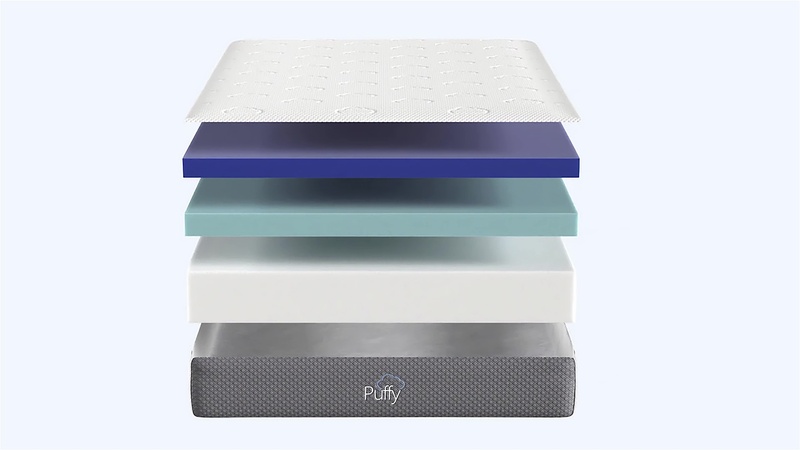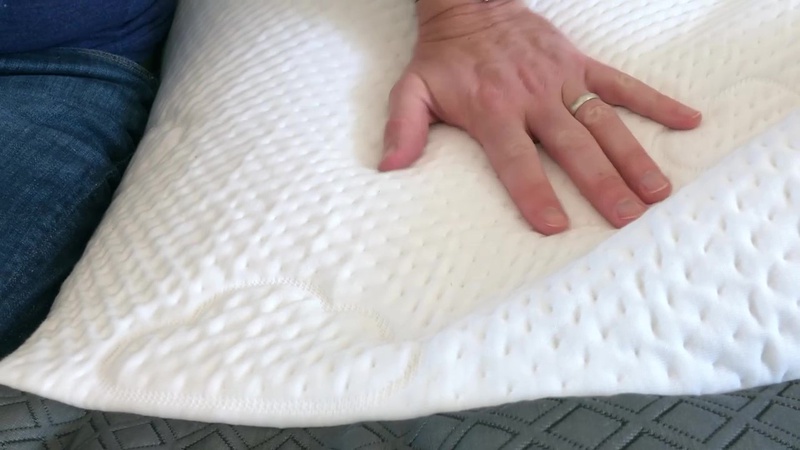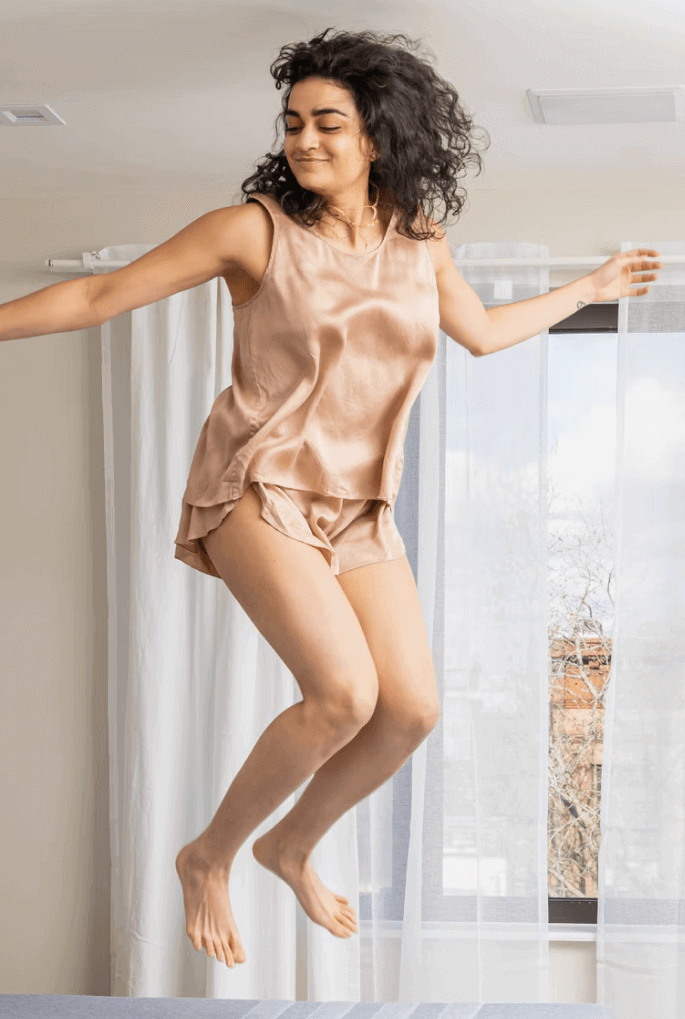Cover
The layers of the Puffy mattress are wrapped in a soft and stretchy cover with clouds stitched into it. It's also notably spill-resistant (though we still recommend you use a mattress protector if you concerned about preventing stains).
The cover is also removable and hand-washable. Machine washing is not recommended, but being able to remove the cover for spot cleaning is a plus.
Comfort & Feel
There are three aspects that make up our assessment of comfort and feel. We call these "preference-based characteristics" because no rating here is better or worse – rather, the attributes that are most desirable to you will be determined solely by your personal preferences. We apply the same classification standards to each mattress so you can more easily compare apples to apples.
Softness ( what’s this )
We classify the Puffy mattress as a Medium in terms of softness, about average among mattresses.
Not sure what softness is best for you? Take our Mattress Match Quiz and find out.
| Softness Level (1=Least Soft, 9=Most Soft) |
5 | Medium |
Cushioning Depth ( what’s this )
While the top foam on the Puffy is a very soft memory foam, it is also fairly quick responding, so you end up with a blend of that "floating on top" feeling versus sinking in deeply.
| Cushioning Depth (1=Shallowest, 9=Deepest) |
5 | Average |
Responsiveness ( what’s this )
We look at responsiveness in two ways. First, we examine how quickly a mattress springs back after being depressed, then we take a look at bounce qualities.
The Puffy has 2" of very soft memory foam on top, but it's fairly quick responding, so it doesn't have that ooey-gooey / quicksand feel that some memory foams do. This same foam tends to absorb motion, so there's no bounce to speak of.
| Memory Feel (1=Least, 9=Most) |
5 | Average |
| Bounce (1=Least, 9=Most) |
2 | No bounce |
Back Support & Pressure Relief
The two things that you should always be sure to get from your mattress are spinal alignment (commonly thought of as "back support") and pressure relief. Unfortunately, no mattress will deliver these two things equally well for all sleepers. In particular, spinal alignment and pressure relief capabilities will vary across sleepers with different weights, body shapes, and sleep positions. To help you determine how this mattress will perform for you, we break down our spinal alignment and pressure relief assessments by sleeper type.
Overall, we thought the Puffy offered good support for sleepers of our tester's size and lighter. (He weighs not quite 200 pounds.) We had concerns for those heavier than our tester.
Spinal Alignment
The key to good back support is maintaining proper spinal alignment while you sleep. This means that the mattress should hold your spine in roughly the same position it's in when you're standing. The ability of a given mattress to do this will generally depend on your weight, sleep position, and body shape.
Here is how we break down the spinal alignment of the original Puffy mattress:
| Weight | Range | Back Sleepers | Side Sleepers | Stomach Sleepers |
| Lighter | <150 lb | 8 | 8 | 8 |
| Average | 150 to 200 lb | 8 | 8 | 8 |
| Above Average | 200 to 250 lb | 8 | 8 | 7 |
| Heavier | >250 lb | 7 | 7 | 6 |
Back Sleepers:
Our 200-pound tester felt well supported on the Puffy mattress. His hips sunk in just enough for the mattress to reach up and cradle his lumbar area. We felt that people of our tester's weight and lighter would have a similar experience. We did question whether those significantly heavier (more than 225 or 250 lbs.) would sink through the beds two inches of memory foam and end up resting on firmer support foam below.
Side Sleepers:
Spinal alignment for our tester in the side position was good, with hips and shoulders sinking into the mattress enough to create a neutral spine. We again thoughts that lighter persons and those a big heavier would also have a good experience with the Puffy in this position. Those significantly heavier (250 lbs.+) might not find enough softness in the top layer and find themselves resting on firmer support foam.
Stomach Sleepers:
Achieving good spinal alignment for stomach sleepers can often be trickier as the hips can tend to sink down too far. And in general, we do not tend to recommend memory foam to stomach sleepers for that reason. However, our tester didn't have any issues on his stomach, and felt his hips did not sink in too much. We would not recommend the mattress for those heavier than our tester that sleep predominantly on their stomachs, however, as we would expect hips to sink too deeply and create a hammocking effect.
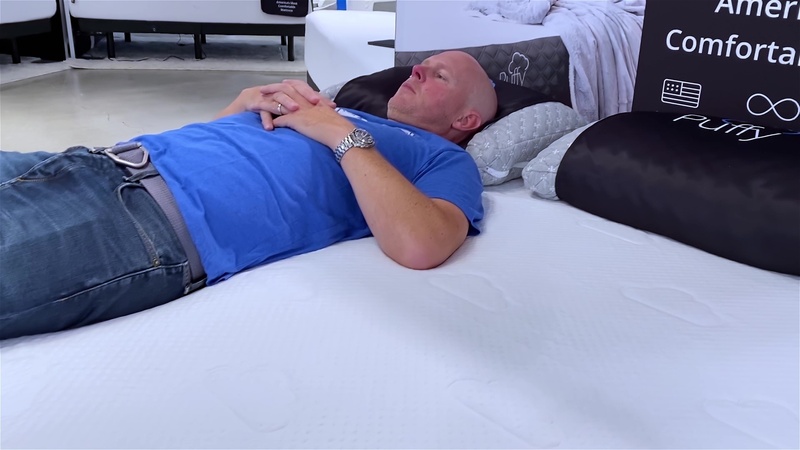
Pressure Relief ( what's this )
When a mattress pushes back against your body with too much force in a concentrated area, the result can be pain, soreness, loss of circulation, excessive tossing, and other problems. In general, such "pressure points" are of greatest concern for side sleepers, since that's the position in which your body's weight is distributed over the smallest surface area. To find the right mattress for your needs, keep in mind that the pressure-relieving capabilities of any given mattress will vary depending on the sleeper. Factors like your weight and body shape (e.g., broader shoulders and/or hips) will determine how far you sink into the mattress, and the pressure relief offered by that mattress will vary widely at different depths.
Here's how we sized up the pressure relief of the Puffy mattress:
| Weight | Range | Typical Curves | Extra Curvy |
| Lighter | <150 lb | 8 | 8 |
| Average | 150 to 200 lb | 7 | 7 |
| Above Average | 200 to 250 lb | 6 | 6 |
| Heavier | >250 lb | 5 | 5 |
Other Features
Beyond the preference-based characteristics of comfort and feel, and the body matching for spinal alignment and pressure relief, a mattress will have a number of other attributes that can make it a better or worse choice for you. We call these "priority-based characteristics" because they are areas in which a mattress can be better or worse, but that will have differing amounts of importance to each sleeper. So, determining how much importance to give to these features will be entirely a matter of your own personal priorities. As always, we apply the same ratings standards to each mattress so you can more easily compare apples to apples.
Motion Isolation ( what’s this )
With a bowling pin standing upright on the Puffy bed, we tested motion isolation by dropping a 16-lb. bowling ball on it, as well as the whole weight of our 200-lb. tester. In both drop tests, the bowling pin barely moved.
We felt that the Puffy bed would be an excellent choice for couples who don’t want to feel their partner getting in and out of bed or repositioning.
| Motion Isolation Rating | 10 /10 | Exceptional |
Temperature ( what’s this )
Aside from some gel in the top 2" of memory foam, the Puffy boasts no particular features to help you stay cool. Most people don't have an issue of sleeping hot, but for those who do, memory foam is often not the best choice for the simple reason that beds with deeper cushioning don't allow as much of your body to be exposed to the air.
That said, our tester had no issues feeling hot on the Puffy bed.
| Stays “Cool” Rating | 4 /10 | Fair |
Edge Support ( what’s this )
While the Puffy mattress does not have any specific edge-support features, we nonetheless felt that edge support was better than expected. When our tester sat on the edge of the bed, he sunk down quite a bit, but did not feel unstable at all. Similarly, when lying on the edge of the bed, he felt very well supported and not at all like he was slipping off too much.
If you find yourself being pushed to the very edge of your mattress by kids or pets, the Puffy mattress would be a good choice. We found edge support on the Puffy to be a hair better than that on the Puffy Lux.
| Edge Support Rating | 7 /10 | Good |
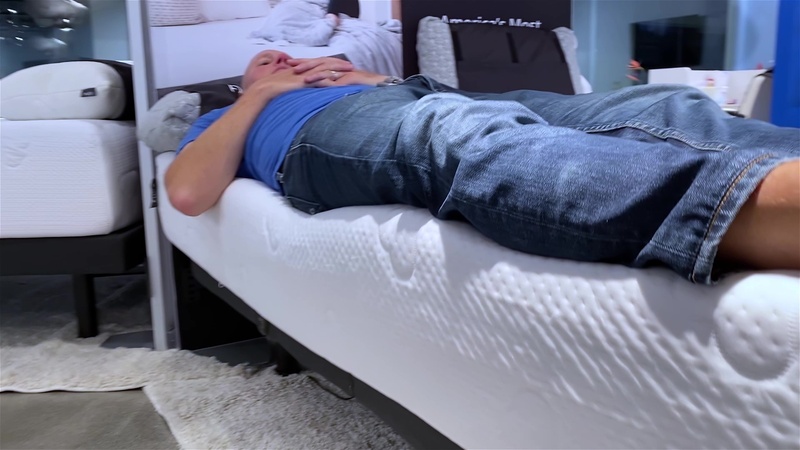
Ease of Repositioning ( what’s this )
Beds that include slow responding memory foam can sometimes hinder movement. However, our tester had no trouble changing positions on the Puffy.
| Repositioning Rating | 8/10 | Very good |
Green Features ( what’s this )
For mattress shoppers concerned with the use of natural materials, sustainable manufacturing practices or the like, we offer our subjective evaluation of any efforts taken by the company to make the mattress more green, healthy, or safe.
| Green Rating | 4 /10 | Fair |
Adjustable Base Compatibility ( what’s this )
We tried the Puffy Original on an adjustable base and it performed very well. The mattress lifted a bit at the foot, something that's to be expected from a new mattress, and something we think would improve over time.
We noticed no uncomfortable bunching of the quilt when the bed was in a bent position.
| Adjustable Base Rating | 8 /10 | Very good |
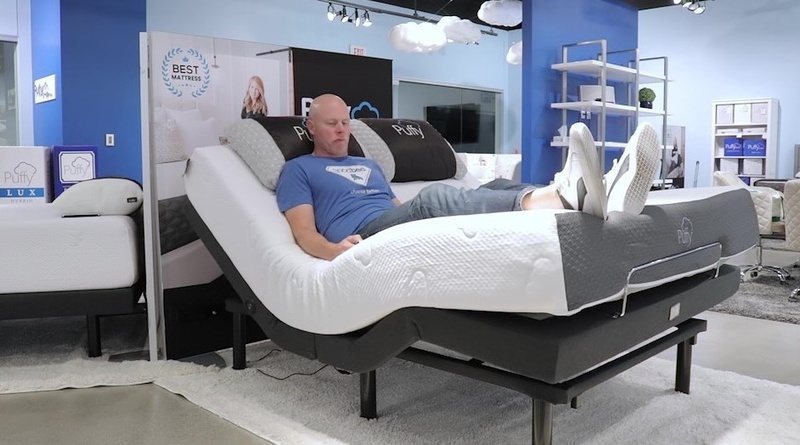
Price, Value & Longevity
How Much Does a Puffy Mattress Cost?
Prices shown are list prices. Remember that GoodBed keeps our site current with the best available discounts on all online mattresses, many of which are exclusive discounts for our readers.
What Are You Getting?
The Puffy is a 10" tall mattress made of foam with 2" of premium memory foam at the top. From a materials and construction standpoint, it is not unique. However, the Puffy has a unique memory foam feel we likened to a marshmallow. It also has an OEKO-tex certified cover, meaning that it's been subjected to testing for harmful chemicals and off-gassing.
How Long Will the Puffy Mattress Last?
When it comes to estimating the lifespan of a mattress, we tend to use foam density as our best, albeit imperfect, predictor of how long a foam will retain its shape and resiliency. In the case of the Puffy Original, the top layer of memory foam is a 2.2-lb density foam, which is below average compared to some of its competition. We can't say for certain if the Puffy will break down prematurely, but if there are any red flags it would be that top foam.
Overall Value
From a value standpoint, the Puffy isn't much of a deal compared to other all-foam mattresses. However, Puffy is known for offering some of the deepest discounts and sales online, so we'd certainly recommend checking GoodBed for discounts, as this can bring the price of a Puffy bed in line with, or even less expensive, than similar memory foam and foam beds.
| Value Rating | 6 /10 | Pretty good |
Other Factors to Consider
Delivery
- Free delivery to your door
Puffy includes free delivery to your door, which is not particularly unusual among its competitors.
Returns
- 101-day trial period
- Full refund with proof of donation
Puffy offers buyers a 101-night trial period, and should you decide to initiate a refund, asks that you donate the mattress to a charity. While that sounds easy enough on the surface (and Puffy is not the only company with this policy), it can actually be difficult to donate a mattress since many organizations will not accept them due to hygiene concerns. Puffy asks that buyers try the mattress for at least 14 days before requesting a refund. See: Puffy return policy
Warranty
- Warranty Length: Lifetime, non-prorated for original owner
- Indentation Coverage: 1.5” and above
One of the biggest, if not THE biggest complaints about any mattress from consumers regards body impressions—the inability of a mattress to spring back, eventually creating a low spot/sinkhole in the mattress. As such, mattress warranties all contain a term defining how big a sag or ‘body impression’ (measured when no one is on the mattress) is considered a defect, and thus covered under the warranty. The industry standard for foam mattresses is generally ¾”. Puffy has chosen to cover indentations that meet or exceed 1.5”, about twice that of competing memory foam mattresses. Practically speaking, that means any softening or sagging would need to be at least that deep before the warranty would offer you protection.
Puffy does, however, offer a lifetime warranty to the original owner, and it's not prorated, meaning that if a material defect is ever found, you get a brand new mattress.










































 Comparison
Comparison
 Related Video Reviews
Related Video Reviews


